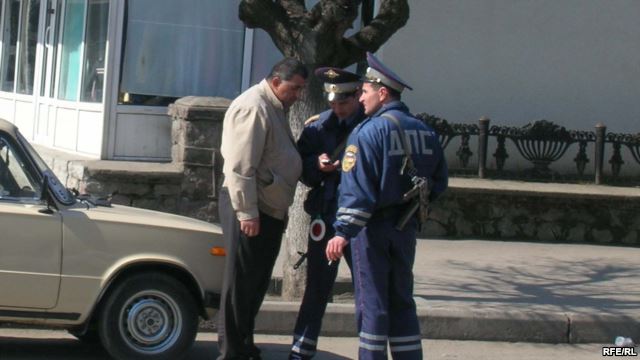
Insurgency Reemerges in Kabardino-Balkaria
Publication: Eurasia Daily Monitor Volume: 11 Issue: 193
By:

Nine years since the militants of Shamil Basaev and Anzor Astemirov ransacked Nalchik, the capital of Kabardino-Balkaria (RIA Novosti, September 7, 2013), on October 13, 2005, this republic remains a territory in a precarious security situation (newsru.com, accessed October 30). The ongoing trial of 57 suspects allegedly involved in that 2005 attack on Nalchik is doing nothing to reduce tensions in this Northwest Caucasus region.
All events in Kabardino-Balkaria usually follow the same familiar pattern. Government forces do not bother to explain the details of their actions. If the stories told in police reports were true, it would mean that practically 99.99 percent of all the militants are ardently willing to die fighting the police. According to law enforcement, the militants invariably start shooting after the police ask them to present their IDs. Most of the time, the militants fail either to kill or injure the police officers, who were supposedly standing right next to them. The suspected rebels are always killed on the spot. Counter-terrorist operations have become routine across the republic (newsru.com, October 5) and residents have adapted to living with a functioning armed underground movement.
This time something went wrong. The Kabardino-Balkarian branch of the National Antiterrorist Committee (NAK) reported that on the morning of October 24, in the village of Uchebny in the republic’s Prokhladny district, a man suspected of aiding the militants resisted arrest, using a handgun and a grenade. A police special forces serviceman was slightly injured in the incident. One of the people in the car of the suspect was killed by return fire, according to NAK (regnum.ru, October 24). According to another report, one police officer was injured and another one received a concussion in the incident (rosbalt.ru, October 24). Since the suspect used a grenade, it means that he probably did not want to surrender to police.
The police in Kabardino-Balkaria regularly extract bribes from motorists, so routine identity checks on the roads are nothing unusual (sevkavportal.ru, October 8). The militants also understand that when instead of a couple of police officers, there is a large group of people, some of them in plain clothes, this suggests they are from the Federal Security Service (FSB). Such a grouping of local law enforcement and FSB agents means the government has information on the militants’ movements. So when militants are stopped under such circumstances, they start shooting and try to run away.
Something like this took place on the evening of October 18, in Nalchik, when traffic police officers stopped a car for a check (polit.ru, October 18). According to the police, people inside the car suddenly started firing at them. One police officer, Martin Shkhakov, died on the spot and the other one was injured (sk-news.ru, October 20). One of the attackers was killed, but the other three suspects managed to escape.
The identity of the slain suspect, 27-year-old Hasan Zalikhanov, turned out to be quite interesting. The police reportedly issued a search warrant for Zalikhanov in 2012, when he was designated as an active member of the illegal armed group that was functioning in Kabardino-Balkaria (Kavkazsky Uzel, October 20). In reality, however, Zalikhanov was put on a list of missing persons in 2012 and only later did the police find out that he had joined the insurgency. In 2013, the police started searching for Zalikhanov on the basis of the articles of the Russian Criminal Code covering attempts on the life of law enforcement officers and illegal weapons possession (consultant.ru, accessed October 30). It is unclear why the investigators accused Zalikhanov of such grave crimes but stipulated that he be put under house arrest as a preventive measure after he is found, not under regular arrest. A possible explanation is that the investigators were unsure of his guilt.
According to the investigators, prior to joining the militants’ ranks, Hasan Zalikhanov served as an instructor of combat and service training at the Ministry of Interior’s Nalchik directorate. The police found Zalikhanov’s service revolver on him, which belonged to him since the time of his service on the police force. The police said Zalikhanov joined the rebels after he was influenced by a friend who had been released from prison after completing a sentence for attempting to kill police officers. In March 2014, law enforcement tried to stop a car carrying Hasan Zalikhanov, but he managed to escape, leaving his police ID behind. One of Zalikhanov’s accomplices was killed and the other managed to escape (Kommersant, October 20).
Hasan Zalikhanov was also suspected of involvement in the murder of the well-known Kabardino-Balkarian journalist Kazbek Gekkiev in the capital on December 5, 2012. He disappeared the same day the journalist was killed, which raised suspicions about his involvement in the murder (apn.ru, December 12, 2012). If Zalikhanov was indeed behind the journalist’s killing, then he was not an ordinary member of the armed Islamic resistance and new information from the emir of Kabardino-Balkaria and Karachi, Salim (Zalim Shebzukhov), should be expected (07.mvd.ru, accessed October 30).
The Russian security services in the North Caucasus consistently seek to kill suspected insurgents and they never try to negotiate the surrender of the militants. Over the past 15 years, apart from Emir Magas (Ali Taziev/Akhmed Yevloev) no other notable figure from the militant underground in the North Caucasus has been tried, which attests to the weakness and low professionalism of the FSB and interior ministry, as well as poor counter-intelligence capabilities to seek out other senior leaders in the regional network of militants. This means clashes between the government forces and the members of the armed resistance in the North Caucasus will continue for a long time to come.




